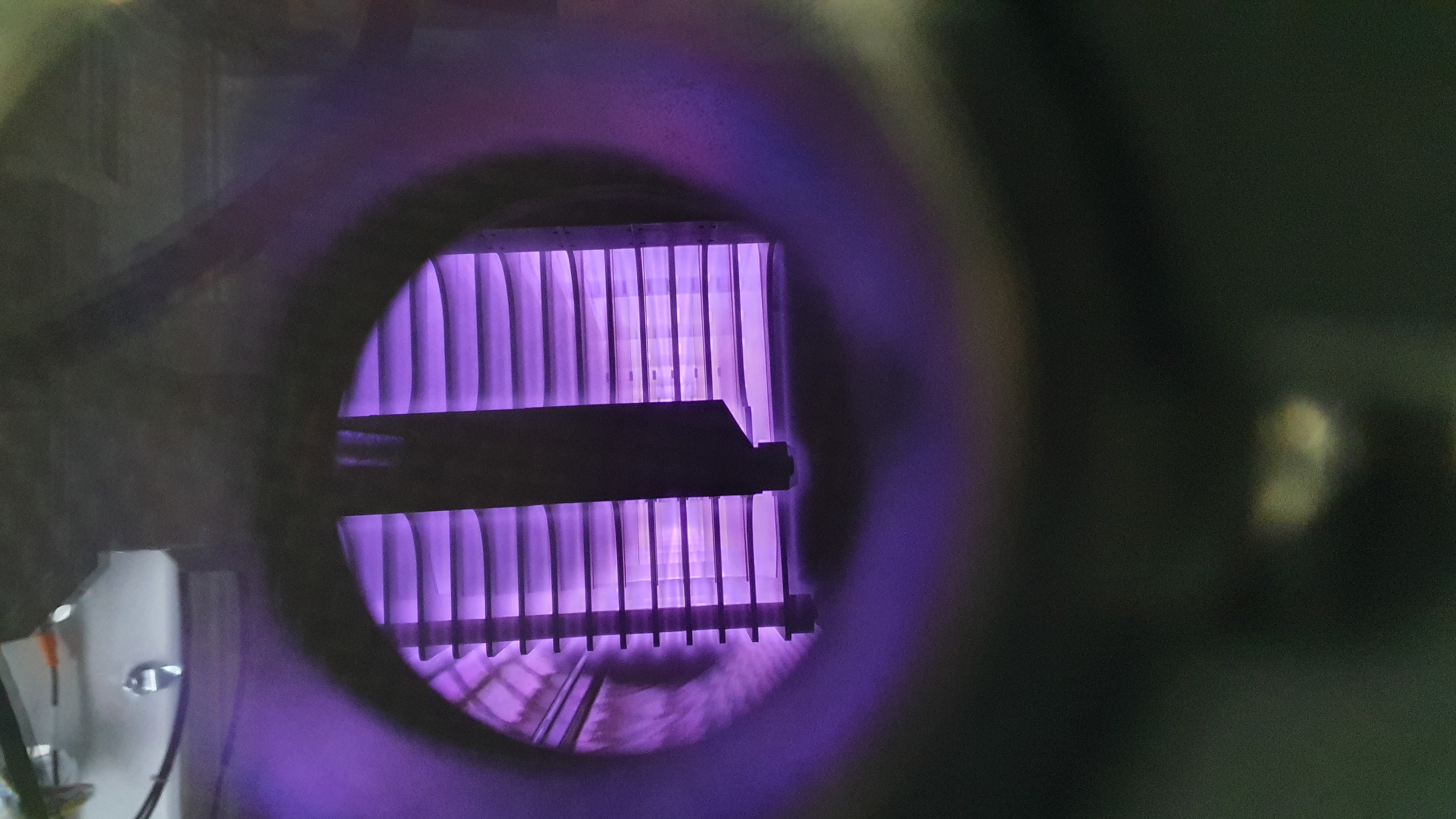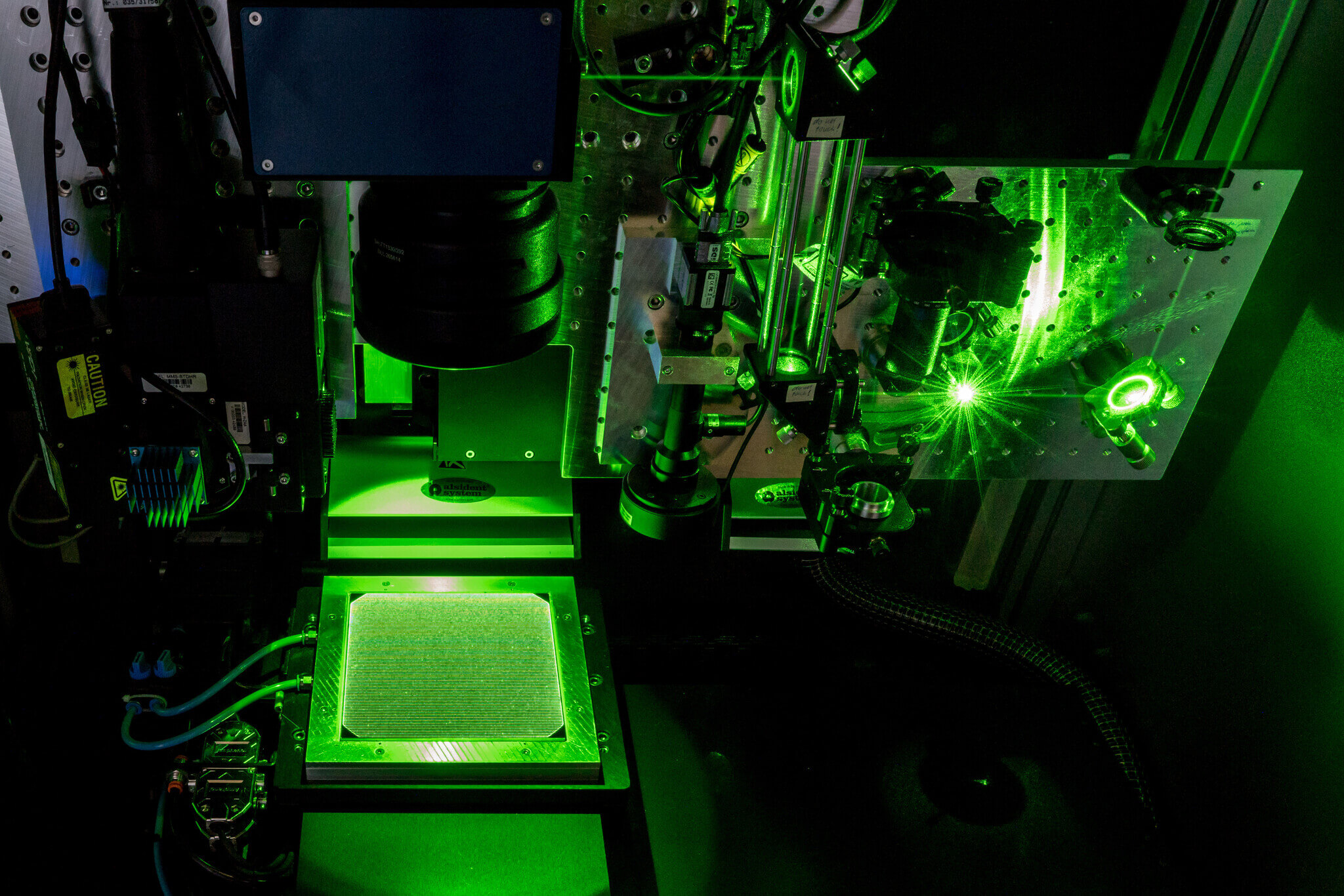Jahr
Year | Titel/Autor:in
Title/Author | Publikationstyp
Publication Type |
|---|
| 2025 |
Impact of string connection and contact defects on electrical current distribution in solar cells and modules: A model validated by magnetic field imaging
Tummalieh, Ammar; Mittag, Max; Weber, Julian; Yucebas, Damla; Schäfer, Levin; Quay, Rüdiger; Reichel, Christian; Neuhaus, Holger |
Zeitschriftenaufsatz
Journal Article
|
| 2025 |
Algorithm for continual monitoring of fog based on geostationary satellite imagery
Jahani, Babak; Karalus, Steffen; Fuchs, Julia; Zech, Tobias; Zara, Marina; Cermak, Jan |
Zeitschriftenaufsatz
Journal Article
|
| 2025 |
Versatile implied open-circuit voltage imaging method and its application in monolithic tandem solar cells
Fischer, Oliver; Bui, Anh Dinh; Schindler, Florian; Macdonald, Daniel; Glunz, Stefan; Nguyen, Hieu T.; Schubert, Martin |
Zeitschriftenaufsatz
Journal Article
|
| 2025 |
Physics-Informed Machine Learning for TCO-Layer Thickness Prediction and Process Analysis from Multi-Spectral Images
Wörnhör, Alexandra; Senthil Kumar, Saravana Kumar; Burkhardt, Daniel; Schönauer, Jonas Johannes Felix; Pingel, Sebastian; Voicu Vulcanean, Ioan; Steinmetz, Anamaria; Rein, Stefan; Demant, Matthias |
Zeitschriftenaufsatz
Journal Article
|
| 2025 |
Wafer-bonded two-terminal III-V//Si triple-junction solar cell with power conversion efficiency of 36.1% at AM1.5g
Schygulla, Patrick; Müller, Ralph; Höhn, Oliver; Schachtner, Michael; Chojniak, David; Cordaro, Andrea; Tabernig, Stefan; Bläsi, Benedikt; Polman, Albert; Siefer, Gerald; Lackner, David; Dimroth, Frank |
Zeitschriftenaufsatz
Journal Article
|
| 2025 |
Implied Voltage and Current Characterization in Organic Solar Cells using Transient Photoluminescence
Faißt, Jared; List, Mathias; Baretzky, Clemens; Bett, Andreas W.; Würfel, Uli |
Zeitschriftenaufsatz
Journal Article
|
| 2025 |
Shingle Cell IV Characterization Based on Spatially Resolved Host Cell Measurements
Kunze, Philipp; Demant, Matthias; Krieg, Alexander; Tummalieh, Ammar; Wöhrle, Nico; Rein, Stefan |
Zeitschriftenaufsatz
Journal Article
|
| 2024 |
A Precise Method for the Spectral Adjustment of LED and Multi-Light Source Solar Simulators
Chojniak, David; Schachtner, Michael; Reichmuth, Kasimir; Bett, Alexander J.; Rauer, Michael; Hohl-Ebinger, Jochen; Schmid, Alexandra; Siefer, Gerald; Glunz, Stefan |
Zeitschriftenaufsatz
Journal Article
|
| 2024 |
Rethinking Electrochemical Deposition of Nickel Oxide for Photovoltaic Applications
Bogachuk, Dmitry; Baretzky, Clemens; Eckert, Jonas; Jang, Bowen; Suo, Jiajia; Dangudubiyyam, Uma Kousalya; Loukeris, Georgios; Mohammadzadeh, Hadi; Kluska, Sven; Kohlstädt, Markus; Würfel, Uli |
Zeitschriftenaufsatz
Journal Article
|
| 2024 |
Perowskite in der Anwendung
Borchert, Anna Juliane; Schmidt-Mende, Lukas |
Zeitschriftenaufsatz
Journal Article
|
| 2024 |
Paste-based Silver Reduction for iTOPCon Rear Side Metallization
Ourinson, Daniel; Brand, Andreas; Lorenz, Andreas; Dhamrin, Marwan; Tepner, Sebastian; Linse, Michael; Göttlicher, Nathalie; Haberstroh, René; Tsuji, Kosuke; Huyeng, Jonas; Clement, Florian |
Zeitschriftenaufsatz
Journal Article
|
| 2024 |
Spectrometric Characterization for Triple-Junction Solar Cells
Aulich, Johanna; Chojniak, David; Bett, Alexander J.; Steiner, Marc; Schindler, Florian; Siefer, Gerald; Schubert, Martin; Goldschmidt, Jan Christoph; Glunz, Stefan |
Zeitschriftenaufsatz
Journal Article
|
| 2024 |
The added value of combining solar irradiance data and forecasts: A probabilistic benchmarking exercise
Lauret, Philippe; Alonso-Suárez, Rodrigo; Amaro e Silva, Rodrigo; Boland, John; David, Mathieu; Herzberg, Wiebke; Le Gall La Salle, Josselin; Lorenz, Elke; Visser, Lennard; van Sark, Wilfried; Zech, Tobias |
Zeitschriftenaufsatz
Journal Article
|
| 2024 |
A prospective ecological risk assessment of high-efficiency III–V/silicon tandem solar cells
Blanco, Carlos Felipe; Quik, Joris T.K.; Hof, M; Fuortes, Agnese; Behrens, Paul; Cucurachi, Stefano; Peijnenburg, Willie; Dimroth, Frank; Vijver, Martina |
Zeitschriftenaufsatz
Journal Article
|
| 2024 |
Improved Uniformity and Anisotropy of Through-Mask Electrochemical Micromachining by Localized Etching and Homogeneous Flow
Jakob, Leonie; Eckert, Jonas; Podevijn, Carl; Kluska, Sven; Junginger, Mathias; Ranzinger, Christian; Bartsch, Jonas |
Zeitschriftenaufsatz
Journal Article
|
| 2024 |
Recent Progress in Monolithic Two-Terminal Perovskite-Based Triple-Junction Solar Cells
Heydarian, Minasadat; Heydarian, Maryamsadat; Schygulla, Patrick; Reichmuth, Kasimir; Bett, Alexander J.; Hohl-Ebinger, Jochen; Schindler, Florian; Hermle, Martin; Schubert, Martin; Schulze, Patricia; Borchert, Anna Juliane; Glunz, Stefan |
Zeitschriftenaufsatz
Journal Article
|
| 2024 |
Stability of industrial gallium-doped Czochralski silicon PERC cells and wafers
Niewelt, Tim; Maischner, Felix; Kwapil, Wolfram; Khorani, Edris; Pain, Sophie L.; Jung, Yujin; Hopkins, Eduard C. B.; Frosch, Manfred; Altermatt, Pietro P.; Guo, Harry; Wang, Yuchin; Grant, Nicholas E.; Murphy, John D. |
Zeitschriftenaufsatz
Journal Article
|
| 2024 |
The Impact of Measurement Conditions on Solar Cell Efficiency
Rauer, Michael; Fell, Andreas; Wöhler, Wilkin; Hinken, David; Reichel, Christian; Bothe, Karsten; Schubert, Martin; Hohl-Ebinger, Jochen |
Zeitschriftenaufsatz
Journal Article
|
| 2024 |
Tunnel Oxide Passivated Contact (TOPCon) Solar Cells
Kafle, Bishal; Richter, Armin |
Aufsatz in Buch
Book Article
|
| 2024 |
Wet chemical poly-Si(n) wrap-around removal for TOPCon solar cells
Krieg, Katrin; Mack, Sebastian; Vollmer, Jan; Dannenberg, Tobias; Brunner, Damian; Zimmer, Martin |
Zeitschriftenaufsatz
Journal Article
|
| 2024 |
Solar degradation and stability of lead-free light absorber Cs2AgBiBr6 in ambient conditions
Jöckel, Dennis Michael; Yoon, Song Hak; Frebel, Alexander; Meles Neguse, Samuel; Rossa, Jürgen Dieter; Bett, Alexander J.; Schubert, Martin; Wiedenmeyer, Marc; Balke-Grünewald, Benjamin; Weidenkaff, Anke |
Zeitschriftenaufsatz
Journal Article
|
| 2024 |
Ultra-Stable ITO-Free Organic Solar Cells and Modules Processed from Non-Halogenated Solvents under Indoor Illumination
Müller, David; Jiang, Ershuai; Campos Guzmán, Laura; Rivas Lazaro, Paula; Baretzky, Clemens; Bogati, Shankar; Zimmermann, Birger; Würfel, Uli |
Zeitschriftenaufsatz
Journal Article
|
| 2024 |
Effect of Inhomogeneous Loads on the Mechanics of a PV Modules
Romer, Pascal; Pethani, Kishan Bharatbhai; Beinert, Andreas |
Zeitschriftenaufsatz
Journal Article
|
| 2024 |
Measuring the Device-Level EQE of Multi-Junction Photonic Power Converters
Schachtner, Michael; Beattie, Meghan N.; Reichmuth, Kasimir; Wekkeli, Alexander; Siefer, Gerald; Helmers, Henning |
Zeitschriftenaufsatz
Journal Article
|
| 2024 |
Solar cell efficiency tables (Version 63)
Green, Martin A.; Dunlop, Ewan D.; Yoshita, Masahiro; Kopidakis, Nikos; Bothe, Karsten; Siefer, Gerald; Hao, Xiaojing |
Zeitschriftenaufsatz
Journal Article
|
| 2024 |
Outdoor measurements of a full-size bifacial Pero/Si tandem module under different spectral conditions
Chojniak, David; Steiner, Marc; Reichmuth, Kasimir; Rößler, Torsten; Schmid, Alexandra; Siefer, Gerald; Glunz, Stefan |
Zeitschriftenaufsatz
Journal Article
|
| 2024 |
Toward Highly Efficient Low-Carbon Footprint Solar Cells: Impact of High-Temperature Processing on Epitaxially Grown p-Type Silicon Wafers
Rittmann, Clara; Meßmer, Pascal; Niewelt, Tim; Supik, Ella Susann; Heinz, Friedemann; Richter, Armin; Botchak Mouafi, Yves P.; Sanz, Sarah; Terheiden, Barbara; Weiss, Charlotte; Drießen, Marion; Schindler, Florian; Janz, Stefan; Schubert, Martin |
Zeitschriftenaufsatz
Journal Article
|
| 2023 |
Insights into circular material and waste flows from c-Si PV industry
Brailovsky Signoret, Peter Henri; Baumann, Kerstin; Held, Michael; Briem, Ann-Kathrin; Wambach, Karsten; Gervais, Estelle; Herceg, Sina; Mertvoy, Boris; Nold, Sebastian; Rentsch, Jochen |
Zeitschriftenaufsatz
Journal Article
|
| 2023 |
Ökobilanzierung: mehr als der CO2-Fussabdruck
Fischer, Marie |
Zeitschriftenaufsatz
Journal Article
|
| 2023 |
Shingling meets perovskite-silicon heterojunction tandem solar cells
Nikitina, Veronika; Reichel, Christian; Erath, Denis; Kirner, Simon; Richter, Alexei; Rößler, Torsten; De Rose, Angela; Kraft, Achim; Neuhaus, Holger |
Zeitschriftenaufsatz
Journal Article
|
| 2023 |
Surface Modification of ITO with N-Heterocyclic Carbene Precursors Results in Electron Selective Contacts in Organic Photovoltaic Devices
Das, Mowpriya; Kohlstädt, Markus; Enders, Maria; Burger, Stephan; Sasmal, Himadri Sekhar; Zimmermann, Birger; Schäfer, Andreas; Tyler, Bonnie J.; Arlinghaus, Heinrich F.; Krossing, Ingo; Würfel, Uli; Glorius, Frank |
Zeitschriftenaufsatz
Journal Article
|
| 2023 |
Contactless Inline IV Measurement of Solar Cells Using an Empirical Model
Kunze, Philipp; Greulich, Johannes; Tummalieh, Ammar; Wirtz, Wiebke; Höffler, Hannes; Wöhrle, Nico; Glunz, Stefan; Rein, Stefan; Demant, Matthias |
Zeitschriftenaufsatz
Journal Article
|
| 2023 |
Indoor Photovoltaics for the Internet-of-Things - A Comparison of State-of-the-Art Devices from Different Photovoltaic Technologies
Müller, David; Jiang, Ershuai; Rivas Lazaro, Paula; Baretzky, Clemens; Loukeris, Georgios; Bogati, Shankar; Paetel, Stefan; Irvine, Stuart J.C.; Olobia, Ochai; Jones, Steve; Lamb, Dan; Richter, Armin; Siefer, Gerald; Lackner, David; Helmers, Henning; Teixeira, Cristina; Forgács, David; Freitag, Marina; Bradford, David; Shen, Zhogjin; Zimmermann, Birger; Würfel, Uli |
Zeitschriftenaufsatz
Journal Article
|
| 2023 |
Insights into perovskite film formation using the hybrid evaporation/spin-coating route: An in situ XRD study
Er-Raji, Oussama; Rustam, Lina; Kore, Bhushan; Glunz, Stefan; Schulze, Patricia |
Zeitschriftenaufsatz
Journal Article
|
| 2023 |
Nanoarchitectonics in fully printed perovskite solar cells with carbon-based electrodes
Bogachuk, Dmitry; Girard, Jessica; Tilala, Siddharth; Martineau, David; Narbey, Stephanie; Verma, Anand; Hinsch, Andreas; Kohlstädt, Markus; Wagner, Lukas |
Zeitschriftenaufsatz
Journal Article
|
| 2023 |
Lateral Currents in Shingle Solar Modules Detected by Magnetic Field Imaging
Klasen, Nils; Weber, Julian; Kraft, Achim; Neuhaus, Holger |
Zeitschriftenaufsatz
Journal Article
|
| 2023 |
Resource-efficient generation of large-area micro and nanostructures
Bläsi, Benedikt; Müller, Martina; Rossmeier, Harald |
Zeitschriftenaufsatz
Journal Article
|
| 2023 |
Measurement of Local Recombination Activity in High Diffusion Length Semiconductors
Heinz, Friedemann; Oezkent, Maximilian; Rittmann, Clara; Schindler, Florian; Schubert, Martin; Kwapil, Wolfram; Glunz, Stefan |
Zeitschriftenaufsatz
Journal Article
|
| 2023 |
Benefits of pairing floating solar photovoltaics with hydropower reservoirs in Europe
Kakoulaki, Georgia; Gonzalez Sanchez , Rocio; Gracia Amillo, Ana Maria; Szabo, Sandor; Felice, Matteo de; Farinosi, Fabio; Felice, Luca de; Bisselink, Berny; Seliger, Roman; Kougias, Ioannis; Jaeger-Waldau, Arnulf |
Zeitschriftenaufsatz
Journal Article
|
| 2023 |
InP- and GaAs-Based Photonic Power Converters Under O-Band Laser Illumination: Performance Analysis and Comparison
Beattie, Meghan; Helmers, Henning; Forcade, Gavin; Valdivia, Christopher; Höhn, Oliver; Hinzer, Karin |
Zeitschriftenaufsatz
Journal Article
|
| 2023 |
Overcoming Throughput Limitations of Laser Systems in Solar Cell Manufacturing via On-The-Fly Processing using Polygon Scanners
Hoppe, Georg; Alvarez Brito, Eduardo Ignacio; Emanuel, Gernot; Nekarda, Jan; Diehl, Moritz; Preu, Ralf; Meyer, Fabian |
Zeitschriftenaufsatz
Journal Article
|
| 2023 |
Numerical Simulation of Thermal Silicon Dioxide Growth in the Gap between Stacked Wafers
Meßmer, Marius; Emmer, Lena; Wolf, Andreas |
Zeitschriftenaufsatz
Journal Article
|
| 2023 |
Bias-voltage photoconductance and photoluminescence for the determination of silicon-dielectric interface properties in SiO2/Al2O3 stacks
Masuch, Paul; Reichel, Christian; Bonilla, Ruy Sebastian; Richter, Armin; Benick, Jan |
Zeitschriftenaufsatz
Journal Article
|
| 2023 |
Mitigation of Shunt in Poly-Si/SiOx Passivated Interdigitated Back Contact Monocrystalline Si Solar Cells by Self-Aligned Etching Between Doped Fingers
Hartenstein, Matthew B.; Nemeth, William; Chen, Kejun; LaSalvia, Vincenzo; Theingi, San; Page, Matthew; Fell, Andreas; Young, David L.; Stradins, Paul; Agarwal, Sumit |
Zeitschriftenaufsatz
Journal Article
|
| 2023 |
Photonen zur Energieübertragung
Helmers, Henning |
Zeitschriftenaufsatz
Journal Article
|
| 2023 |
High Lifetime Ga-doped Cz-Si for Carrier-Selective Junction Solar Cells
Horzel, Jörg; Mack, Sebastian; Voicu Vulcanean, Ioan; Zimmermann, Karin; Pingel, Sebastian; Kwapil, Wolfram; Maischner, Felix; Höffler, Hannes; Bashardoust, Sattar; Wagenmann, Dirk; Greulich, Johannes; Seif, Johannes; Steinmetz, Anamaria; Rentsch, Jochen |
Zeitschriftenaufsatz
Journal Article
|
| 2023 |
Paste Development for an Optimized Filament Stretching Effect During Parallel Dispensing on Transparent Conductive Oxide Layers for Solar Cell Metallization
Gensowski, Katharina; Palme, Melanie; Langhof, Ivy; Akyüz, Resul; Auerbach, Simon; Tepner, Sebastian; Clement, Florian |
Zeitschriftenaufsatz
Journal Article
|
| 2023 |
Mask and plate: a scalable front metallization with low-cost potential for III-V-based tandem solar cells enabling 31.6 % conversion efficiency
Schube, Jörg; Höhn, Oliver; Schygulla, Patrick; Müller, Ralph; Jahn, Mike; Mikolasch, Gabriele; Steiner, Marc; Predan, Felix; Bartsch, Jonas; Dimroth, Frank; Clement, Florian; Keding, Roman |
Zeitschriftenaufsatz
Journal Article
|
| 2023 |
Electronic Band Offset Determination of Oxides Grown by Atomic Layer Deposition on Silicon
Khorani, Edris; Meßmer, Christoph Alexander; Pain, Sophie L.; Niewelt, Tim; Healy, Brendan; Ailish, Wratten; Walker, Marc; Grant, Nicholas E.; Murphy, John D. |
Zeitschriftenaufsatz
Journal Article
|
| 2023 |
Every Cell Needs a Beautiful Image: On-The-Fly Contacting Measurements for High-Throughput Production
Kurumundayil, Leslie Lydia; Ramspeck, Klaus; Rein, Stefan; Demant, Matthias |
Zeitschriftenaufsatz
Journal Article
|
| 2023 |
Photovoltaics: Towards 50 percent efficiency
Höhn, Oliver |
Zeitschriftenaufsatz
Journal Article
|
| 2023 |
Multifunctional Titanium Oxide Layers in Silicon Heterojunction Solar Cells formed via Selective Anodization
Jakob, Leonie; Tutsch, Leonard; Hatt, Thibaud; Westraadt, Johan; Ngongo, Sinoyolo; Glatthaar, Markus; Bivour, Martin; Bartsch, Jonas |
Zeitschriftenaufsatz
Journal Article
|
| 2023 |
Upscaling of Perovskite-Silicon Tandem Solar Cells
Schultz-Wittmann, Oliver; Hermle, Martin; Goraya, Baljeet Singh; Nold, Sebastian; Schulze, Patricia |
Zeitschriftenaufsatz
Journal Article
|
| 2023 |
III-V Material Growth on Electrochemically Porosified Ge Substrates
Winter da Costa, Edgard; Schreiber, Waldemar; Schygulla, Patrick; Lustoza de Souza, Patricia; Janz, Stefan; Lackner, David; Ohlmann, Jens |
Zeitschriftenaufsatz
Journal Article
|
| 2023 |
The Impact of Different Hydrogen Configurations on Light- and Elevated-Temperature-Induced Degradation
Hammann, Benjamin; Assmann, Nicole; Weiser, Philip M.; Kwapil, Wolfram; Niewelt, Tim; Schindler, Florian; Søndenå, Rune; Monakhov, Eduard V.; Schubert, Martin |
Zeitschriftenaufsatz
Journal Article
|
| 2023 |
Translation of Outdoor Tandem PV Module I-V Measurements to a STC Power Rating
Steiner, Marc; Siefer, Gerald |
Zeitschriftenaufsatz
Journal Article
|
| 2023 |
Thermomechanical design rules for photovoltaic modules
Beinert, Andreas; Romer, Pascal; Heinrich, Martin; Aktaa, Jarir; Neuhaus, Holger |
Zeitschriftenaufsatz
Journal Article
|
| 2023 |
State-of-play and emerging challenges in photovoltaic energy yield simulations: A multi-case multi-model benchmarking study
Tsanakas, Ioanis (John) A.; Lokhat, Ismaël; Jay, Arnaud; Gregoire, Clément; Schnierer, Branislav; Rusnak, Jozef; Dvonc, Lukas; Barthelot, Joséphine; Monet, Chloé; Garcia, Kevin; Lombardero, Iván; Leloux, Jonathan; Sarr, Babacar; Armbruster, Alfons; Bor, Jefferson |
Zeitschriftenaufsatz
Journal Article
|
| 2023 |
Stable chemical enhancement of passivating nanolayer structures grown by atomic layer deposition on silicon
Pain, Sophie L.; Khorani, Edris; Niewelt, Tim; Wratten, Ailish; Walker, Marc; Grant, Nicholas E.; Murphy, John D. |
Zeitschriftenaufsatz
Journal Article
|
| 2023 |
Improved Light Utilization Efficiency for an ITO-Free Semitransparent Organic Solar Cell Using a Multilayer Silver Back Electrode as Infrared Mirror
Pap, Leonie; Schirmacher, Bertolt; Bloch, Esther; Bogati, Shankar; Viehmann, Philipp; Scheel, Arnulf; Müller, David; List, Mathias; Zimmermann, Birger; Würfel, Uli |
Zeitschriftenaufsatz
Journal Article
|
| 2023 |
On the Conversion Between Recombination Rates and Electronic Defect Parameters in Semiconductors
Juhl, Mattias K.; Heinz, Friedemann; Coletti, Gianluca; Rougieux, Fiacre; Sun, Chang; Vacqueiro Contreras, Michelle; Niewelt, Tim; Krich, Jacob; Schubert, Martin |
Zeitschriftenaufsatz
Journal Article
|
| 2023 |
Solar cell efficiency tables (Version 61)
Green, Martin A.; Dunlop, Ewan D.; Siefer, Gerald; Yoshita, Masahiro; Kopidakis, Nikos; Bothe, Karsten; Hao, Xiaojing |
Zeitschriftenaufsatz
Journal Article
|
| 2023 |
The effect of passivation to etching duration ratio on bipolar electrochemical etching of porous layer stacks in germanium
Schreiber, Waldemar; Liu, Tingzhu; Janz, Stefan |
Zeitschriftenaufsatz
Journal Article
|
| 2023 |
A Grain Orientation-Independent Single-Step Saw Damage Gettering/Wet texturing Process for Efficient Silicon Solar Cells
Jung, Yujin; Min, Kwan Hong; Post, Regina; Kwapil, Wolfram; Schubert, Martin; Kim, Donghwan; Kang, Yoonmook; Lee, Hae-Sok |
Zeitschriftenaufsatz
Journal Article
|
| 2023 |
A Plasma Chemistry Model for H2/SiH4 Mixtures Used in PECVD Processes
Sushkov, Vladimir; Rachdi, Lazhar; Hofmann, Marc |
Zeitschriftenaufsatz
Journal Article
|
| 2023 |
Analysing Grid-Level Effects of Photovoltaic Self-Consumption Using a Stochastic Bottom-up Model of Prosumer Systems
Karalus, Steffen; Köpfer, Benedikt; Guthke, Philipp; Killinger, Sven; Lorenz, Elke |
Zeitschriftenaufsatz
Journal Article
|
| 2023 |
Comparison of PVT - heat pump systems with reference systems for the energy supply of a single-family house
Chhugani, Bharat; Pärisch, Peter; Helmling, Sebastian; Giovannetti, Federico |
Zeitschriftenaufsatz
Journal Article
|
| 2023 |
Inline Characterization of Ultrathin Amorphous Silicon Stacks in Silicon Heterojunction Solar Cell Precursors with Differential Reflectance Spectroscopy
Senthil Kumar, Saravana Kumar; Vahlman, Henri; Al-Hajjawi, Saed; Diestel, Christian; Haunschild, Jonas; Rupitsch, Stefan; Rein, Stefan |
Zeitschriftenaufsatz
Journal Article
|
| 2023 |
Atomic Force Microscopy Analysis of Aluminum Layer Properties and Correlation to Masking Functionality in Copper Plating Metallization for Solar Cells
Hatt, Thibaud; Morawietz, Tobias; Bartsch, Jonas; Tutsch, Leonard; Glatthaar, Markus |
Zeitschriftenaufsatz
Journal Article
|
| 2023 |
How to assess the electrical quality of solar cell interconnection in shingle solar modules
Weber, Julian; Rößler, Torsten |
Zeitschriftenaufsatz
Journal Article
|
| 2023 |
Spectrometric Characterization of Monolithic Perovskite/Silicon Tandem Solar Cells
Bett, Alexander J.; Chojniak, David; Schachtner, Michael; Reichmuth, Kasimir; Kabakli, Özde Seyma; Schulze, Patricia; Fischer, Oliver; Schindler, Florian; Hohl-Ebinger, Jochen; Siefer, Gerald; Schubert, Martin |
Zeitschriftenaufsatz
Journal Article
|
| 2023 |
Simulation of Colored BIPV Modules Using Angular-Dependent Spectral Responsivity
Clasing, Lionel; Riedel-Lyngskær, Nicholas; Reiners, Nils; Blieske, Ulf |
Zeitschriftenaufsatz
Journal Article
|
| 2023 |
Process influences on LeTID in Ga-doped silicon
Maischner, Felix; Kwapil, Wolfram; Greulich, Johannes; Jung, Yujin; Höffler, Hannes; Saint-Cast, Pierre; Schubert, Martin; Rein, Stefan; Glunz, Stefan |
Zeitschriftenaufsatz
Journal Article
|
| 2023 |
Silicon-based passivating contacts: The TOPCon route
Glunz, Stefan; Steinhauser, Bernd; Polzin, Jana-Isabelle; Luderer, Christoph; Grübel, Benjamin; Niewelt, Tim; Okasha, Asmaa; Bories, Mathias; Nagel, Henning; Krieg, Katrin; Feldmann, Frank; Richter, Armin; Bivour, Martin; Hermle, Martin |
Zeitschriftenaufsatz
Journal Article
|
| 2023 |
Modeling of thin-film interference filters on structured substrates: Microfacet-based BSDF versus ray tracing
Wessels, Andreas; Christen, Leonard; Callies, Adrian; Kroyer, Thomas; Höhn, Oliver; Bläsi, Benedikt |
Zeitschriftenaufsatz
Journal Article
|
| 2023 |
Proton radiation hardness of GaInAsP alloys for space solar cell applications
Pellegrino, Carmine; Schön, Jonas; Lang, Robin; Dimroth, Frank; Zimmermann, Claus G.; Lackner, David |
Zeitschriftenaufsatz
Journal Article
|
| 2023 |
Understanding the Impact of the Cooling Ramp of the Fast-Firing Process on Light- and Elevated-Temperature-Induced Degradation
Hammann, Benjamin; Aßmann, Nicole; Schön, Jonas; Kwapil, Wolfram; Schindler, Florian; Roder, Sebastian; Monakhov, Eduard V.; Schubert, Martin |
Zeitschriftenaufsatz
Journal Article
|
| 2023 |
Risk-based due diligence in supply chains: The case of silver for photovoltaics
Gervais, Estelle; Kleijn, René; Nold, Sebastian; Voet, Ester van der |
Zeitschriftenaufsatz
Journal Article
|
| 2023 |
Curing conditions for low-resistivity contacts on transparent conductive oxide layers for different solar cell applications
Gensowski, Katharina; Freund, Timo; Much, Maximilian; Muramatsu, Kazuo; Tepner, Sebastian; Clement, Florian |
Zeitschriftenaufsatz
Journal Article
|
| 2023 |
Understanding Contact Nonuniformities at Interfaces in Perovskite Silicon Tandem Solar Cells Using Luminescence Imaging, Lock-In Thermography, and 2D/3D Simulations
Fischer, Oliver; Fell, Andreas; Meßmer, Christoph Alexander; Efinger, Raphael; Schindler, Florian; Glunz, Stefan; Schubert, Martin |
Zeitschriftenaufsatz
Journal Article
|
| 2023 |
Impact of Organic Particles from Wafer Handling Equipment on Silicon Heterojunction Pseudo-Efficiency
Fischer, Andreas; Voicu Vulcanean, Ioan; Pingel, Sebastian; Steinmetz, Anamaria |
Zeitschriftenaufsatz
Journal Article
|
| 2023 |
Mechanisms of Silicon Surface Passivation by Negatively Charged Hafnium Oxide Thin Films
Wratten, Ailish; Pain, Sophie L.; Walker, David; Renz, Arne B.; Khorani, Edris; Niewelt, Tim; Grant, Nicholas E.; Murphy, John D. |
Zeitschriftenaufsatz
Journal Article
|
| 2023 |
Low-temperature Metallization & Interconnection for Silicon Heterojunction and Perovskite Silicon Tandem Solar Cells
De Rose, Angela; Erath, Denis; Nikitina, Veronika; Schube, Jörg; Güldali, Derya; Minat, Ädem; Rößler, Torsten; Richter, Alexei; Kirner, Simon; Kraft, Achim; Lorenz, Andreas |
Zeitschriftenaufsatz
Journal Article
|
| 2023 |
Unraveling the Energetic Landscape of Perovskite Solar Cells: A Synergy of 2D Drift-Diffusion Simulations and Tapered Cross Section Photoelectron Spectroscopy
Baretzky, Clemens; Maheu, Clément; Frericks, Markus; Mayer, Thomas; Würfel, Uli |
Zeitschriftenaufsatz
Journal Article
|
| 2023 |
On the Robustness of the Determination of Metal-Induced Recombination from Photoluminescence Images on Solar Cells
Leon, Cyril; Saint-Cast, Pierre; Fell, Andreas; Greulich, Johannes; Rein, Stefan |
Zeitschriftenaufsatz
Journal Article
|
| 2023 |
Representativeness of Energy Rating acc. to IEC 61853 for Different Locations in Middle and South Europe
Rivera Aguilar, Mariella Josefina; Reise, Christian; Kräling, Ulli |
Zeitschriftenaufsatz
Journal Article
|
| 2023 |
Structuring of perovskite-silicon tandem solar cells for reduced reflectance and thermalization losses
Callies, Adrian; Hanser, Mario; Goldschmidt, Jan Christoph; Bläsi, Benedikt; Höhn, Oliver |
Zeitschriftenaufsatz
Journal Article
|
| 2023 |
Effective radiative recombination coefficient of p-AlGaAs for varying aluminium concentrations
Schygulla, Patrick; Lang, Robin; Lackner, David |
Zeitschriftenaufsatz
Journal Article
|
| 2023 |
LeTID Mitigation via an Adapted Firing Process in p-Type PERC Cells from Gallium-doped Czochralski Silicon
Maischner, Felix; Greulich, Johannes; Kwapil, Wolfram; Ourinson, Daniel; Glunz, Stefan; Rein, Stefan |
Zeitschriftenaufsatz
Journal Article
|
| 2023 |
Monolithic Two-Terminal Perovskite/Perovskite/Silicon Triple-Junction Solar Cells with Open Circuit Voltage > 2.8 V
Heydarian, Maryamsadat; Heydarian, Minasadat; Bett, Alexander J.; Bivour, Martin; Schindler, Florian; Hermle, Martin; Schubert, Martin; Schulze, Patricia; Borchert, Anna Juliane; Glunz, Stefan |
Zeitschriftenaufsatz
Journal Article
|
| 2023 |
Combining Circularity and Environmental Metrics to Assess Material Flows of PV Silicon
Zubas, Aistis Rapolas; Fischer, Marie; Gervais, Estelle; Herceg, Sina; Nold, Sebastian |
Zeitschriftenaufsatz
Journal Article
|
| 2023 |
TOPCon Shingle Solar Cells: Thermal Laser Separation and Passivated Edge Technology
Lohmüller, Elmar; Baliozian, Puzant; Gutmann, Leon; Kniffki, Leander; Richter, Armin; Wang, Lili; Dunbar, Ricky; Lepert, Arnaud; Huyeng, Jonas; Preu, Ralf |
Zeitschriftenaufsatz
Journal Article
|
| 2023 |
Thermal laser separation and high-throughput layer deposition for edge passivation for TOPCon shingle solar cells
Lohmüller, Elmar; Baliozian, Puzant; Gutmann, Leon; Kniffki, Leander; Beladiya, Vivek; Geng, Jürgen; Wang, Lili; Dunbar, Ricky B.; Lepert, Arnaud; Hofmann, Marc; Richter, Armin; Huyeng, Jonas |
Zeitschriftenaufsatz
Journal Article
|
| 2023 |
Low-Cost Outdoor Spectral Irradiances Determination and its Application on Concentrator Photovoltaic Module Power Rating and Energy Yield Calculation
Steiner, Marc; Martinez Sanchez, Juan Francisco; Mathur, Paresh; Sarkar, Subrata; Siefer, Gerald |
Zeitschriftenaufsatz
Journal Article
|
| 2023 |
Hydrogen Reactions in c-Si:B During Illumination at Room Temperature
Kwapil, Wolfram; Hammann, Benjamin |
Zeitschriftenaufsatz
Journal Article
|
| 2023 |
Quantifying Surface Recombination - Improvements in Determination and Simulation of the Surface Recombination Parameter J0s
Hammann, Benjamin; Steinhauser, Bernd; Fell, Andreas; Post, Regina; Niewelt, Tim; Kwapil, Wolfram; Wolf, Andreas; Richter, Armin; Höffler, Hannes; Schubert, Martin |
Zeitschriftenaufsatz
Journal Article
|
| 2023 |
Maximizing Current Density in Monolithic Perovskite Silicon Tandem Solar Cells
Heydarian, Minasadat; Meßmer, Christoph Alexander; Bett, Alexander J.; Heydarian, Maryamsadat; Chojniak, David; Kabakli, Özde Seyma; Tutsch, Leonard; Bivour, Martin; Siefer, Gerald; Schubert, Martin; Goldschmidt, Jan Christoph; Hermle, Martin; Glunz, Stefan; Schulze, Patricia |
Zeitschriftenaufsatz
Journal Article
|
| 2023 |
Exploring hafnium oxide’s potential for passivating contacts for silicon solar cells
Wratten, Ailish; Pain, Sophie L.; Yadav, Anup; Khorani, Edris; Niewelt, Tim; Black, Lachlan; Bartholazzi, Gabriel; Walker, David; Grant, Nicholas E.; Murphy, John D. |
Zeitschriftenaufsatz
Journal Article
|
| 2023 |
High-frequency rheological and piezo-voltage waveform characterization of inkjet-printed polymer-based dopant-source inks
Hussain, Zulkifl; Kiaee, Zohreh; Tuladhar, Tri R.; Reichel, Christian; Tepner, Sebastian; Nazarzadeh, Milad; Jahn, Mike; Keding, Roman |
Zeitschriftenaufsatz
Journal Article
|
| 2023 |
Can synergies in agriculture through an integration of solar energy reduce the cost of agrivoltaics? An economic analysis in apple farming
Trommsdorff, Maximilian; Hopf, Michaela; Hörnle, Oliver; Berwind, Matthew; Schindele, Stephan; Wydra, Kerstin |
Zeitschriftenaufsatz
Journal Article
|

















